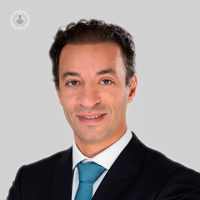How LASIK helps correct astigmatism
Written by:LASIK (laser-assisted in situ keratomileusis) is a form of laser refractive surgery. It is one of the most common eye procedures performed all over the world because of its high rate of predictability, safety, and excellent visual outcomes.
It is used to correct myopia (shortsightedness), hypermetropia (longsightedness), astigmatism, and recently it was used to correct presbyopia (losing the ability to read from a short distance after the age of 40 years).
We asked one of our leading ophthalmologists Mr Radwan Almousa to explain more about how the procedure works on astigmatism and what can be expected from the outcome.

Who is eligible for LASIK for astigmatism?
LASIK is indicated to treat up to 4 dioptres of astigmatism in the UK according to the NICE guidelines. It is recommended for patients above the age of 21 at which the refractive error is usually stable. Most surgeons are happy to treat up to 3 dioptres of astigmatism, after which other surgical methods are safer and might give better visual outcomes.
How does it work to fix astigmatism?
As it does for other refractive errors (myopia and hypermetropia), LASIK uses the femtosecond laser to shape the corneal surface to make it more regular. Corneas with astigmatism have different curvature steepness in different meridian and it looks like a rugby ball in comparison to a football that has a unified surface curvature. To correct astigmatism, the femtosecond laser reshapes the corneal surface to make it closer to a more regular surface (like a football).
How successful is LASIK for astigmatism?
LASIK has a high efficacy and safety index and predictability with 97% of patients achieving postoperative uncorrected vision of ≥ 20/40 (driving performance). Approximately 62% of eyes achieve 20/20 (perfect vision), including treating astigmatism as most patients will have some amount of astigmatism corrected alongside, however, only significant astigmatism (>0.75D) needs to be corrected.
What should patients make sure they ask their LASIK surgeon?
The patient should check with his surgeon the reason for his visual symptoms and if it is related to a refractive error or another eye problem. Also, the patient should inquire about the best method of correcting the refractive error, visual expectation after surgery and the possible risks associated with the surgery.
Is LASIK the only option to fix astigmatism?
Astigmatism can be corrected with other laser surgical platforms, such as PRK and SMILE. Also for a higher amount of astigmatism (>3D) or if there is a contraindication for the corneal procedure (like a thin cornea, highly irregular corneal shape) other procedures can be recommended. One option is implanting an ICL lens (implantable Collamer lens) inside the eye, which can provide a better visual outcome.
You can book an appointment with Mr Almousa via his Top Doctor's profile here if you would like to discuss your treatment options for astigmatism.


